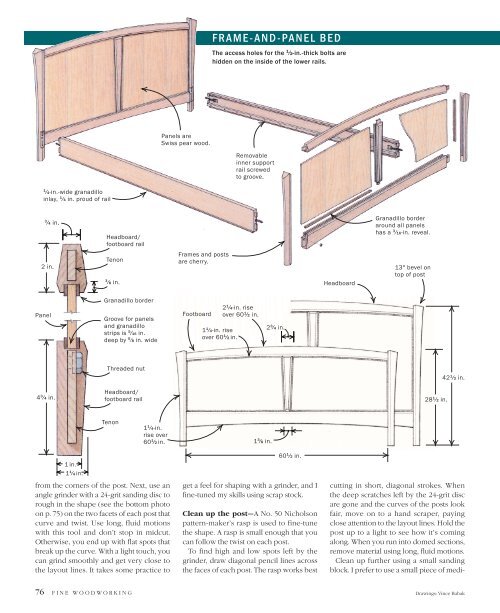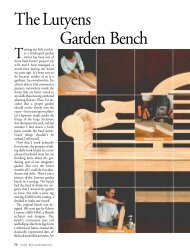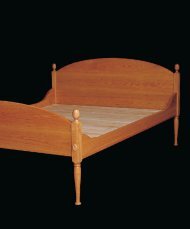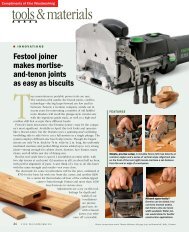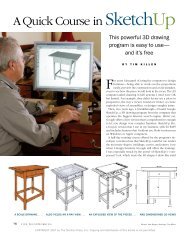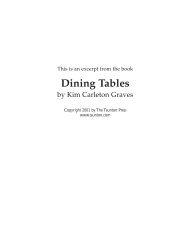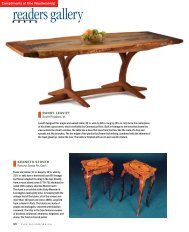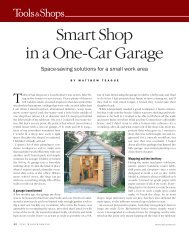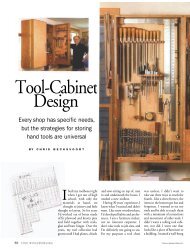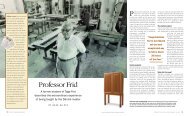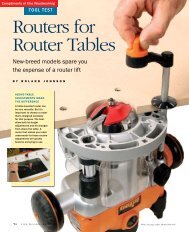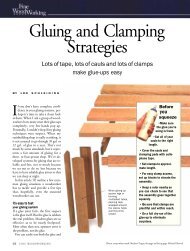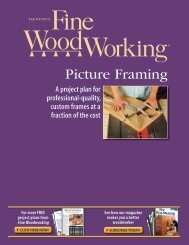Frame-and-Panel Bed - Fine Woodworking
Frame-and-Panel Bed - Fine Woodworking
Frame-and-Panel Bed - Fine Woodworking
You also want an ePaper? Increase the reach of your titles
YUMPU automatically turns print PDFs into web optimized ePapers that Google loves.
FRAME-AND-PANEL BED<br />
The access holes for the 1 ⁄2-in.-thick bolts are<br />
hidden on the inside of the lower rails.<br />
<strong>Panel</strong>s are<br />
Swiss pear wood.<br />
Removable<br />
inner support<br />
rail screwed<br />
to groove.<br />
1<br />
⁄4-in.-wide granadillo<br />
inlay, 1 ⁄4 in. proud of rail<br />
3<br />
⁄4 in.<br />
Headboard/<br />
footboard rail<br />
Granadillo border<br />
around all panels<br />
has a 3 ⁄16-in. reveal.<br />
2 in.<br />
Tenon<br />
3<br />
⁄8 in.<br />
<strong>Frame</strong>s <strong>and</strong> posts<br />
are cherry.<br />
Headboard<br />
13° bevel on<br />
top of post<br />
<strong>Panel</strong><br />
Granadillo border<br />
Groove for panels<br />
<strong>and</strong> granadillo<br />
strips is 5 ⁄16 in.<br />
deep by 5 ⁄8 in. wide<br />
Footboard<br />
1 1 ⁄4-in. rise<br />
over 60 1 ⁄2 in.<br />
2 1 ⁄4-in. rise<br />
over 60 1 ⁄2 in.<br />
2 3 ⁄4 in.<br />
4 3 ⁄4 in.<br />
Threaded nut<br />
Headboard/<br />
footboard rail<br />
28 1 ⁄2 in.<br />
42 1 ⁄2 in.<br />
Tenon<br />
1 1 ⁄4-in.<br />
rise over<br />
60 1 ⁄2 in.<br />
1 3 ⁄8 in.<br />
1 in.<br />
1 1 ⁄4 in.<br />
from the corners of the post. Next, use an<br />
angle grinder with a 24-grit s<strong>and</strong>ing disc to<br />
rough in the shape (see the bottom photo<br />
on p. 75) on the two facets of each post that<br />
curve <strong>and</strong> twist. Use long, fluid motions<br />
with this tool <strong>and</strong> don’t stop in midcut.<br />
Otherwise, you end up with flat spots that<br />
break up the curve. With a light touch, you<br />
can grind smoothly <strong>and</strong> get very close to<br />
the layout lines. It takes some practice to<br />
60 1 ⁄2 in.<br />
get a feel for shaping with a grinder, <strong>and</strong> I<br />
fine-tuned my skills using scrap stock.<br />
Clean up the post—A No. 50 Nicholson<br />
pattern-maker’s rasp is used to fine-tune<br />
the shape. A rasp is small enough that you<br />
can follow the twist on each post.<br />
To find high <strong>and</strong> low spots left by the<br />
grinder, draw diagonal pencil lines across<br />
the faces of each post. The rasp works best<br />
cutting in short, diagonal strokes. When<br />
the deep scratches left by the 24-grit disc<br />
are gone <strong>and</strong> the curves of the posts look<br />
fair, move on to a h<strong>and</strong> scraper, paying<br />
close attention to the layout lines. Hold the<br />
post up to a light to see how it’s coming<br />
along. When you run into domed sections,<br />
remove material using long, fluid motions.<br />
Clean up further using a small s<strong>and</strong>ing<br />
block. I prefer to use a small piece of medi-<br />
76 FINE WOODWORKING Drawings: Vince Babak


